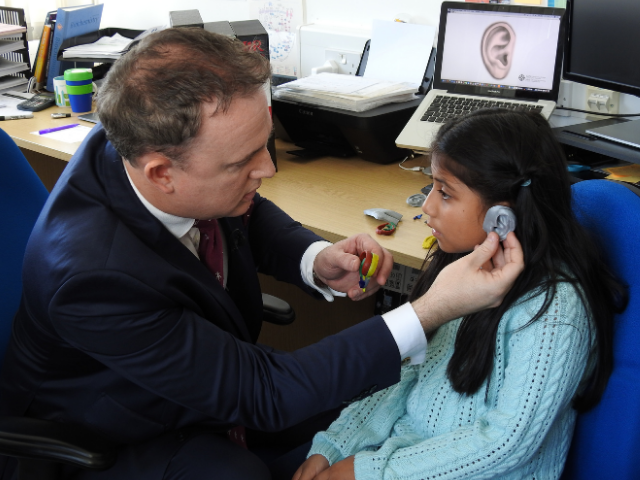
Barking up the right tree
Eight year old Radiyah desperately wants to have her ears pierced, just like many girls her age. For Radiyah though it’s a bit more of a challenge – when she was born, her left ear hadn’t grown fully.
Radiyah is now facing a series of operations so surgeons can construct a new ear that looks the same as her right one.
One of the operations involves removing part of Radiyah’s ribcage to use as tissue (cartilage). This is a potentially painful procedure and it’s also likely to leave a scar.
But there could be another way.
Professor Iain Whitaker, Health and Care Research Wales’ Specialty Lead for plastic surgery, is working on a novel approach that might help Radiyah in the future. He’s aiming to bioprint ears by creating cartilage from a natural biomaterial found in tree bark.
“The major barrier to plastic surgery is improving form and function but we need to take tissue from elsewhere in the body,” said Professor Whitaker.
“We’re doing nice surgery, taking bits out, taking cancers out, making things look nicer but there’s a pay-off taking things from elsewhere, such as pain and scarring, so it’s always been my passion to try and get around that clinical conundrum.”
In Professor Whitaker’s lab in Swansea University, there are floor to ceiling incubators and a couple of 3D bioprinting machines.
Zita Jessop and Tom Jovic are academic plastic surgery registrars working in Professor Whitaker’s team.
Essentially, they’re making an ‘ink’ to print the different shaped elements which make up an ear. To do this they’re mixing patients’ nasal cells with the tree bark material.
“A lot of groups throughout the world are using plastic materials for their bioprinting because it’s a lot easier to print,” said Tom.
“However, it’s been shown that when plastic materials are put into humans they often invoke an immune reaction because it’s a foreign material.”
The ‘ink’ has to be the right consistency to be pushed through a printer nozzle but it also has to be strong enough to set as a solid and maintain its shape. That’s where the tree bark material comes in.
“It’s a cellulose material so it’s very printable,” explained Zita. “It’s got the right mechanical properties so when you squeeze it out it flows very well, which means that the cells don’t get put under undue pressure.
“Then once it’s printed we spray a material on to make it hardened, we call it crosslinking. And what we’ve shown is that the tree bark material has the fibres within it that mimic the natural collagen fibres of tissue, specifically cartilage.”
“The bonus of using a natural material like the one we’re using is it’s known to have a low immunogenic profile,” added Tom, “so it’s generally perceived to be safe and well tolerated by the immune system.”
Radiyah is one of Professor Whitaker’s patients and she’s been attending regular clinic appointments for the last five years.
“We’ve been going back and forth to hospital and they’ve been showing us patients who have had the operation where the rib is removed to form an ear,” said Radiyah’s dad Rana.
They’re deciding whether to go ahead with the traditional procedure or to hold out for Professor Whitaker’s research to be completed.
“We are willing to wait to see if this new technology becomes available,” said Rana. “We would like Radiyah to have an operation before secondary school so she doesn’t miss classes but if it’s not available then we would need to wait a bit longer.”
Professor Whitaker’s research has the backing of two of the world’s leading plastic surgery bodies - the American Association of Plastic Surgeons (AAPS) and the European Association of Plastic Surgeons (EURAPS). Earlier this year, he was awarded an AAPS/EURAPS academic scholarship to form a research collaboration with Massachusetts General Hospital and Harvard Medical School.
As part of the collaboration, this cutting-edge research will travel from Swansea to the States so it can be tested in animal models. It’s hoped the results will be published next year.
Although the aim is to bioprint ears, the full impact of this research could be much wider reaching. “I hope it will give patients a new treatment option, which means they don’t have to have bits taken from elsewhere in the body with the obvious scarring, pain and length of time in hospital,” said Professor Whitaker.
“We’re starting with cartilage and facial reconstruction but it’s my hope that we’ll move on to different tissue types and different body areas, which could lead to new reconstructive options for patients with birth defects or illness or disease, such as cancer.”
As for Radiyah, she’s a bit nervous about having an operation, whenever that might be, but she’s mainly looking forward to it.
“I really want to get my ears pierced and tie my hair back,” said Radiyah.
Radiyah’s even picked out the type of earrings she wants to wear: “Diamond ones!”
First published: @ResearchWales Issue 7, November 2019